Sunday, April 30, 2006
Title:Hell (L'Enfer)
Cast: Emmanuelle Béart, Karin Viard, Marie Gillain, Guillaume Canet, Jacques Gamblin, Pierre
Jacques Perrin, Carole Bouquet, Miki Manojlovic, Georges Siatidis
Director: Danis Tanovic
L'Enfer is the story of 3 women. Sophie, Anne and Cecile. 3 sisters, though the stories unfold independently for the most part. Only in the end do we start to see the connections and the reasons behind events. Sophie is married with kids and lives in her parents house, but her life is falling apart as her husband is cheating on her. Anne is having an affair with a married man, but her life is falling apart as he has just dumped her in favour of his family. Cecile is the one that visits their mother, wheelchair bound and mute, and she appears to have picked up a stalker.
As the film progresses the characters act out their personal tragedies, their own domestic little hells. The film starts with their father being released from prison, but until we know exactly what happened between the father and the mother we don't really understand. Then everything falls into place, the actions of each of the girls echoing the past by degrees. Perpetuating the tragedy, and with references to Medea, revenge and the consumption of children, giving it a mythic edge. Of course in turn this makes events more pathetic, the characters fighting to turn the tide, already trapped by repetition for all their efforts.
The Polish born writer/director Krzysztof Piesiewicz is most well known for his Three colours trilogy - Red, White and Blue. But before his death he worked on a second trilogy - Heaven, Hell, and Purgatory. The first film Heaven was directed by German director Tom Twyker, his first film in English it was set in Italy and had an Australian (Cate Blanchett) and American (Giovanni Ribisi) cast. The second film Hell is by director Danis Tanovic, the Bosnian director who was responsible for the film No Man's Land. Like the Three Colours, Tanovic's contribution to Piesiewicz's series is in French, featuring the well known actress Emmanuelle Béart (8 Women, Nathalie, etc), Guillaume Canet (Love Bites, Love Me If You Dare), and the naggingly familiar Marie Gillain. While Heaven features explosions and helicopters, and bares the stylistic marks of Twyker, Hell is a more straightforward affair, and you wouldn't know the two were related at all.
Monday, April 24, 2006
Title:Adventure (Une Aventure)
Cast: Ludivine Sagnier, Nicolas Duvauchelle, Bruno Todeschini, Florence Loiret-Caille, Estelle Vincent
Director: Xavier Giannoli
Adventure (Une Aventure) showed as part of this year's French Film Festival, and the only film there that I managed to catch. Actress Ludivine Sagnier stars, familiar from a number of films by Francois Ozon, most prominently of which would be Swimming Pool. Here she plays a troubled woman called Gabrielle.
Julien and Cecile are a young couple who have just moved in together. He works funny hours at the Library of Cinema. One night he gets home late and realises that he doesn't have his keys. While he waits for Cecile to wake up and let him in Gabrielle appears. This strange woman standing bare foot in the street, staring at him, tears streaming down her face. He moves towards her and she wanders off, disappearing before he can do anything. This happens a couple of times, until one day he bumps into Gabrielle during the day, and despite several encounters she doesn't recognise him in the slightest. Gradually Julien is drawn into Gabrielle's life. It becomes clear that she is a sleep walker, and Julien takes on a kind of guardian angel role. Of course this looks strange to Cecile, and Gabrielle's perhaps gangster boyfriend.
Adventure is something of a misleading title for this film, since it isn't really an adventure as such. The film really focuses of Gabrielle and the hints that she had a bad past, that has traumatised her and that is expressed through her harmful nocturnal activities. The film muddles along, but it doesn't really make much of the material on offer - little is made of the relationship between Gabrielle and Julian other than demonstration of his growing interest, little is made of the tension that introduces to the relation with Cecile, and little is made of Gabrielle's boyfriend. Overall Adventure is ok, but nothing special.
Saturday, April 22, 2006
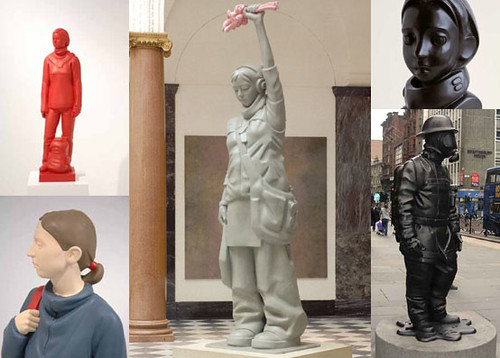
Title:Feedback Loop
Artist: Kenny Hunter
Promotion: Scottish Arts
Last night I came across a flyer for the promotion of New Art for Scotland, the cover image particularly caught my eye. Shown centrally above is the piece Feedback Loop by artist Kenny Hunter, which is currently on display at Aberdeen Art Gallery & Museum. I decided to look up some of his other work - shown above we have the figure in red "Standing Woman", below that "Woman with Rucksack”. The last image is the point where I realise that I have been familiar with Hunter’s work for years – the black figure of a fire-fighter stands outside Glasgow’s Central Station and is something I see all the time.
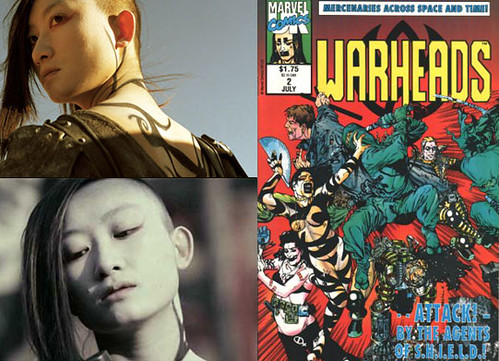
Title:Seven Swords (Chat Gim)
Cast: Leon Lai, Charlie Yeung, Donnie Yen, Liwu Dai, So-yeon Kim, Duncan Chow, Chia-Liang Liu, Yi Lu, Jingwu Ma, Jason Pai Piao, Honglei Sun, Michael Wong, Jingchu Zhang
Director: Hark Tsui
The Emperor has banned martial arts. Taking it to such an extreme that his soldiers will get money for each martial artist that they kill. A man arrives in a village of martial artists, having fled a massacre, warning that an army is on the way. This army will kill every last one of them, women and children all, claiming each head for the money. But the village don't trust this man; they know him as a government agent. Fortunately a couple of the younger villagers believe his story, help him escape, and join him on his journey to the holy mountain. The man was one of the seven sword masters and is looking to retake his sword and reassemble the masters to fight the enemy.
Obviously Seven Swords is just another version of the Seven Samurai, though given that the Chinese title is Chat Gim it is clear that the English title is not a direct translation. To a degree the style reflects the influence of Crouching Tiger/Flying Daggers. At least that is the theory, the reality is a little more dated feeling - Seven Swords doesn't have the same feeling of spectacle as the afore mentioned films. There is some striking scenery, but even that isn't especially exploited.
Unfortunately Seven Swords only had a short run on its recent UK release. The result was that I caught a late night showing, which is something I do quite often anyway. On this occasion, I was either particularly tired, or bored, since I kept having to stop myself from nodding off. Perhaps I would have gotten more from Seven Swords had I seen it at a different point. Instead I felt it was a bit lacklustre, getting more of a retro martial arts feel from it than I would have liked.
The best thing about the Seven Swords for me, was the evil army. They were made up to look fierce, elaborate armour, faces painted white, black tribal markings. All of which reminded me of something that artist Gary Erskine would draw. Particularly the girl, with her shaved Mohawk and manic energy, who was the coolest thing about the film - reminding of a character from Erskine's short run comic Warheads.
Thursday, April 20, 2006
Title:The Libertine
Cast: Johnny Depp, Samantha Morton, John Malkovich, Rosamund Pike, Johnny Vegas, Jack Davenport
Director: Laurence Dunmore
First there was Shakespeare In Love. Man, woman, stage, sex.
Then there was Stage Beauty. Man, woman, stage, sex.
But a bit darker.
Then there is The Libertine. Man, woman, stage, sex.
But syphilitic, drugged up, full of dildoes, and midgets riding penis chariots. What next?
The Libertine is set shortly after the time period that features in Stage Beauty. Women have taken to the stage after a period of puritanism, with Charles II on the throne to promote a looser society. However Johnny Depp is the titular Libertine, an aristocrat in exile due to his excess. However John Malcovich's Charles is willing to give Depp another go.
So Depp returns to London. Where thanks to his excessive lifestyle, and been done that attitude, he is quickly bored. Dangerously so. Until he sees a young actress played by Samantha Morton, who isn't very good, but he reckons with his patronage she could be great. With Depp's new interest in the theatre, the King assigns him the task of coming up with a play for the visit of the French ambasador - something special. Of course this is a mistake, cue a play built around Morton celebrating spring and sexuality, replete with as many phallic objects as they can get on stage. This time, he has gone too far!
Like I say, The Libertine is a bit like Shakespeare In Love and Stage Beauty, but stripping it down to the grubbiest, filthiest, most lurid level. Depp devours the screen, over acting and over the top, his libertine equals parts Captain Jack Sparrow (Pirates Of The Carribean) and Inspector Fred Abberline (From Hell). Samantha Morton and Rosamund Pyke (Depp's long suffering wife) are both strong, though particularly under used. Though it is possibly Johnny Vegas as an aristocrat dandy that sees the film at its most absurd.
Wednesday, April 19, 2006
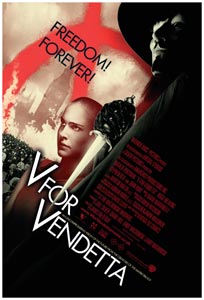
Title:V For Vendetta
Cast: Natalie Portman, Hugo Weaving, Stephen Rea, Stephen Fry, John Hurt, Tim Pigott-Smith, Roger Allam
Director: James McTeigue
Evey Hammond works for a TV company, and is risking the curfew to meet her boss for dinner. Unfortunately she is caught by agents of the government's secret police, who are going to have their wicked way with her. However she is rescued by V, a man in a Guy Fawkes mask, who then escorts her to witness the blowing up of the Old Bailey and Lady Justice. While the police are unable to identify the man in the mask, they are able to identify Evey Hammond.
So the police come for her at work - the TV station - the place that V is in the process of attacking so that he can broadcast his message to the country. The current regime has had long enough, it has come to power using the excuse of terror, and now uses terror to maintain power - one year from today V will blow up parliament, those that agree with him should gather and show their support. In the confusion that follows Evey saves V from the police, only to be knocked out - forcing V to take her with him and hold her until his plans are completed.
The rest of the film covers a year - the 5th of November to the 5th of November. A year of growing unrest. A year of authoritarian discomfort. In that time V picks off a number of important people, the police piecing together the story a step behind each new murder.
From the first paragraph, anyone familiar with Alan Moore and David Lloyd's book V For Vendetta should be able to spot that there are differences in the plot to this film adaptation written by the Wachowski Brothers. To a degree this is to be expected, Moore extrapolated from events in the 1980's to give a fascist state a few years later, the Wachowski's have done similar from the present. Rather than Moore's nuclear incident, we have a bio-terrorist attack that has changed the face of politics as people responded to events. The idea of terror is perhaps even more relevant to today's politics than the politics of when the book was originally written. As such it plays a bigger part in this film - the story just about jumps up and down shouting about the politics of manipulation, the politics of exploiting terror to take power, of how the destruction of just one building can change everything. Though the irony is, the destruction of a building got us into the political state we are, while the film suggests the destruction of one building will sort everything out.
As an adaptation V For Vendetta is at its best when it is closest to the source material. When Hugo Weaving is allowed to play V as an over the top and flamboyant character he is brilliant. Where he has to apologize or explain himself to Evey he is weakened and undermined. Even more so when the film tries to develop more between V and Evey. Some of the tensions and twists of the book are removed, which to a degree is understandable as films usually strip down some. Though this seems to provide more space to make political noises again. The changes in the character Gordon who Evey uses for shelter are interesting - to a degree in the book he added a seediness, mixing in with the overall conspiracies, here Stephen Fry plays him as a closet gay television host, which instead adds emphasis to some of the extremes of the establishment and their reactions to race and sexuality. Something that was already a strong theme in the book.
There are undoubtedly flaws with V For Vendetta. The periodic moments of violence, which owe too much to The Matrix, and aren't in keeping with the film as a whole. Or the entirely over the top prison camp scene, which we flashback to on a number of occasions. However Weavings V, Stephen Rea's Finch, and Portman particularly during Evey's forced awakening, all balance the scores. Indeed, while it isn't necesarily saying much, V For Vendetta is undoubtedly the best adaptation of one of Alan Moore's books to date.
Tuesday, April 18, 2006
Title:The Fog
Cast: Tom Welling, Maggie Grace (that blonde lassie from Lost), Selma Blair
Director:Rupert Wainwright
Title:The Hills Have Eyes
Cast: Tom Bower, Ted Levine, Kathleen Quinlan, Dan Byrd, Emilie de Ravin (that other blonde lassie from Lost), Aaron Stanford, Vinessa Shaw
Director: Alexandre Aja
Well. If "Hollywood" has become too lazy to do new films, then I guess I'll become too lazy to do separate and original reviews? The Fog and The Hills Have Eyes both have a lot in common. Both being remakes of horror films. Both featuring actresses from the hit TV series Lost in prominent roles. Both spend too much time explaining what they are about, to the point where any idiot should get it well before the 100th repetition. Both are based on films by people with a certain debateable reputation - John Carpenter (The Fog) and Wes Craven (The Hills).
The films do have some differences. The Fog is effects heavy, while The Hills is rawer and nastier. Though neither are particularly striking, original, or actually worthwhile. The Fog has that kid superman from Smallville and the more worthwhile Selma Blair. The Hills has direction by Alexandre Aja, who was responsible for the French horror Haute Tension. Despite it's flaws Haute Tension was more original and stylistic than many. Which would suggest that The Hills should be similarly so, but instead it falls into the rut of just being another film exactly the same as dozens of others.
Even as dumb/popcorn movies, neither of these films is particularly worth your while.

Title:Peyton Amberg
Cast: Tama Janowitz
Director: Bloomsbury
Ok. I admit it. I've given up reading Peyton Amberg. I don't think I'm that far away from finishing it. So probably if I made an effort I could finish it. But I really can't be bothered; I have no enthusiasm or interest in finishing it. Being a novel that didn't meet my expectations, based on the extract I stumbled upon on the publisher's website.
Peyton Amberg is the titular character in this novel by Tama Janowitz. An attractive woman who isn't particularly interested in sex or men. So when a Jewish dentist from a good family suggests marriage she goes along with it. They come from different backgrounds, her family is barely one step away from the trailer park, while his are affluent. Still they marry, have a son, and she keeps her job as a travel agent. But as the marriage goes on, as he works long hours, makes bad decisions and generally complains about how difficult life is, she starts to become interested in sex, just not with him.
As we are introduced to Peyton we meet a woman in her 50's who still has her lush good looks. At least, since she is the narrator, she believes this to be the case. However, as she pursues a man in his 20's in Belgium, it is suggested that she is far removed from her glory days. So the question is - how did Peyton become this human wreckage? With this first chapter, one would hope that Janowitz would spend the rest of the novel answering that question, all in the course of a novel I have seen described as Sex In The City meets Fight Club.
As the novel progresses, Peyton goes on a series of trips thanks to her work as a travel agent. She travels to Brazil, to Hong Kong and the like - there she meets rich playboys, or sleazy gangsters. Each chapter launching a new adventure, only to trigger a dull memory about life with her husband which goes on to dominate the rest of the chapter. So instead of the promised exotic adventures, the raw human fire of a crash and burn case, we get turgid domestic Americana. We get a novel that shouts loudly about being one thing, while delivering a shallow fragment of would it could have been. So I struggled, and I surrendered.
Monday, April 17, 2006
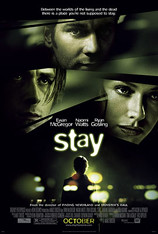
Title: Stay
Cast: Ewan McGregor, Ryan Gosling, Naomi Watts, Elizabeth Reaser, Bob Hoskins, Janeane Garofalo, B.D. Wong, John Dominici, Jessica Hecht
Director: Marc Forster
Sam Foster (Ewan McGregor) is standing in for Dr. Beth Levy (Janeane Garofalo), who seems to have had some kind of breakdown. Of prime concern is patient Henry Letham (Ryan Gosling), who through some coaxing seems to be suggesting that he is responsible for the death of his parents, and like his favourite artist he intends to kill himself on his 21st birthday, which is in 3 days time. The issue of suicide is a particularly touchy subject for Foster, his own girlfriend Lila Culpepper (Naomi Watts) has the scars to prove it. Of course when Foster meets Henry's parents, experiences deja vu and a series of other weird things happen, it is clear that there is something strange going on.
Stay builds tension from the start. Working it up as it gets increasingly weirder. Before delivering the big surprise, the punch line of what is really going on. Of course, one problem is that I, at least, knew what that big surprise was from the start. It was obvious. I have seen the same big twist in half a dozen other films, one of which was in the last month, and read at least one Philip K. Dick novel with the same idea. The problem, to a degree is that the creators of this film behave as though it is a revelation. The question is, is going over this ground again a problem in itself?
In recent interviews for the Pink Panther, Steve Martin talks about how we don't criticise a new production of a play just because it has been done someone else, so why do we criticise films? Of course one of the big issues with the remakes of films is that they are often pale imitations of the previous version. Stay isn't a remake, but the base principal of re-exploring material is still at the core of the thought. It is hard to discuss examples without giving the game away, and while it might be a plot I'm familiar with, there is always the chance that someone reading this hasn't.
The other films I can think of though tend toward horror/thriller, and to a degree there is a thriller subtext here - as Foster desperately tries to find Henry before he kills himself. Stay is a high budget, glossy film, with a director like Marc Forster (Finding Neverland, Monsterball) that shouldn't be entirely surprising. With that it sets a higher bar visually than some of the lower budget/teen thrillers that have gone before. The director having slipped my mind while I watched Stay, I would have half said that this was someone's first film, graduating from directing pop videos and commercials. Balancing lush dream like sequences with music video sensibilities. There being two scenes that include dancers and lingering shots accompanied by music. Of course to balance that, there are at least three stair scenes, each creating a different spiralling/layering shot that allows the director to play with fancy shots and create certain moods. On the other hand it reminds of the work of Marc Evans (My Little Eye, Trauma), with the quirky suspenseful undertones.
Gradually Stay is one of those films that I become more impressed than I had initially thought I would be. The sense of having seen it all before overwhelms in the first instance. So it takes time for the idea to filter through, that while the material provided here has been done a dozen times before, it has never quite been done like this. To a degree the approach is self-conscious, deliberate. To a degree this feels like a pretentious and self-important film. But I suspect it doesn’t matter, that to a degree Stay is worth seeing for all that.
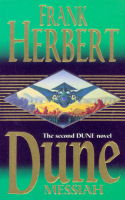
Title: Dune Messiah
Author: Frank Herbert
Publisher: Gollancz
Of the six novels that exist today as Frank Herbert's Dune series, Dune Messiah is the second and slightest volume. From the end of Dune the jihad has swept across the universe, consolidating power behind Emperor Paul Artriedes on his Dune planet. Mystery and awe surrounds Paul and his sister Alia, generating religion and changing everything. The powers that were however are not content to retreat - the guild of steersmen (the spice based navigators who control space travel), the bene gesserat (the body of reverend mothers responsible for the creation and loss of Paul and his sister) and the bene teilleuax (masters of black science who managed to stop their own creation gone out of control in the past). Together they scheme, ever more elaborate plots, determined to bring down the Artriedes family and seize power over their co-conspirators.
This is the basis of Dune Messiah. A novel where nothing particularly happens. In Dune great and epic battles happened between chapters, Herbert uses the same technique here. So that each chapter focuses on a couple of people, or a small group sitting around and talking - contemplating oracular time lines and the plots against them, or trying to block the reading of oracular time lines while plotting against them. This takes on a narrative sparseness, the sense that we are perpetually on the cusp of something happening, something that never comes. Or at least, when events take on a weight of their own, they happen while two people talk, and a messenger enters stage right to supply the news of events. With that Dune Messiah has something Shakespearian to it, a building tragedy, where characters wrestle with words on balconies, babbling stygian prophecy and waiting to be interrupted by messengers.

Title: Transamerica
Cast: Felicity Huffman, Kevin Zegers
Director: Duncan Tucker
Bree is a woman in a man’s body. Or at least, what’s left of a man’s body. One more operation and Bree will be a woman in a woman’s body. An operation she will have in one week’s time. Except that she has just discovered that she has a son. The product of a mistaken college relationship. Brie decides to take the easy option – denial.
However her psychologist doesn’t accept this. Her psychologist sees this as evidence that she is not prepared for her operation, and that gender issues still exist. And without the psychologist’s signature then Brie can’t have that operation. So she has to go meet her son, and come to terms with him.
Toby is in prison awaiting bail for holding drugs, a 17-year old who has been turning tricks in the streets of New York to make ends meet. When Bree arrives he assumes she is from a church group, and she makes no effort to tell him the truth. Instead she decides to drive him back to his home town, not realising that an abusive step-father awaits them.
As they travel together Bree must come to terms with her sex, with her relation to her son, and her relation to her own parents. For the most part Transamerica is a clever little American Indy - that no doubt benefits from the Felicity Huffman’s role in Desperate Housewives. And undoubtedly Huffman dominates the film with the strength of her performance. Exuding an awkwardness as character gets increasingly out of her depth in her attempts to establish a new life. However the film drags a little – at times feeling somewhat episodic, which tends to give it something of a patchy feel. Regardless it is a decent little film – the combination of Huffman’s performance and the feeling of being well removed from Hollywood working in the film’s favour.
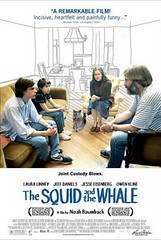
Title: The Squid And The Whale.
Cast: Jeff Daniels, Laura Linney, Jesse Eisenberg, Owen Kline, Halley Feiffer, Anna Paquin, William Baldwin
Director: Noah Baumbach
Bernard (Jeff Bridges) and Joan’s (Laura Linney) marriage is not working. Their two sons have started to see the signs. The shouting, the fighting. Eventually they have to split, taking joint custody of the children. Despite its intention this puts the two boys under enormous pressure and it isn’t long before they start to break.
Bernard is a once great writer. A pretentious shit of a man. Filled with startling illusions of his own grandeur. Illusions with which he has brainwashed his older son, who is fast on his way to becoming a pretentious shit of a man, without the benefit of having actually read any of the books that he spouts forth about. He blames his mother for the break up, accusing her of dropping Bernard because of his flagging career, especially as hers is just taking off. The fact that she had an affair doesn’t help, but given just how much of a complete shit Bernard is, who could blame her?
The Squid And The Whale is a film that follows the break up of a family. Set in 1986, the film is shot in such a way that it takes on the feel of actually having been filmed in 1986. Which to a degree is kind of a curious effect, unless it was just a side effect of being made cheaply? The performances by the four leads are strong and intense, but given just how thoroughly dislikeable Bernard and his son are and the general negativity of emotions on display, one does start to wonder why one bothered. To a degree with the strength of those two male characters, Linney is overwhelmed, we don’t really get into her – other than as a distraught woman who is too quick to talk about personal detail.
The meaning of the title doesn’t become clear until quite near the end and is actually the point where we actually start to get some sense of redemption from the film.
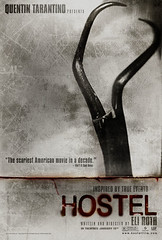
Title: Hostel
Cast: Jay Hernandez, Derek Richardson, Eythor Gudjonsson, Barbara Nedeljakova, Jan Vlasák, Jana Kaderabkova, Jennifer Lim, Keiko Seiko, Petr Janis, Takashi Miike
Director: Eli Roth
Two Americans are touring round Europe with an Icelandic guy they’ve hooked up with. They’ve reached Amsterdam – the latest stop of their search for pussy and drugs. But after a tour of the hash bars, clubs and red light district, they meet a man who assures them that the best women are East. So they head to a Hostel in Bratislava that he has recommended to them. The most absurdly plush backpacker’s hostel ever. Where they are greeted by a bevy of eager women, only too happy to feed them drops and pussy. But when their Icelandic friend disappears, it becomes clear that things are too good to be true.
Hostel is the latest film from the geniuses Quentin Tarantino and Eli Roth, at least that is how the trailers for the film put it. I would beg to differ, and had in fact planned to steer clear of the film in the first place. But sometimes you arrive at the cinema looking to see a film, only to find so few options suit your window of opportunity. That is my excuse and I’m sticking to it.
For a good chunk of the film Hostel bares more resemblance to a teen sex comedy like Euro Trip rather than the exceedingly shocking horror it claims to be. The last half hour is where things really change pace. And then it takes on more of the feel of a thriller, hinting that bad things are going to happen and that the lead must do his best to get away from those who would do the bad things to him. A certain grisliness does come to the fore as Hostel reaches a climax, providing a couple of uncomfortable moments. But in the end Hostel is surprisingly tame given its own hype, and overall it’s a pretty average film. The most interesting and bemusing aspect of the film is the cameo by Japanese director Takashi Miike, who naturally has more talent than anyone else associated with Hostel.
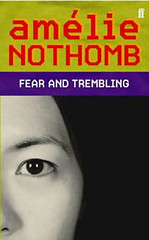
Title: Fear And Trembling
Author: Amelie Nothomb
Publisher: Faber and Faber
The film Fear And Trembling showed in one of the annual French Film Festivals that play around the UK a few years ago. It was based on the book by Belgian writer Amelie Nothomb. Born in Japan to Belgian parents, she lived there until she was five. Having left the country, she recalled her time there fondly, and dreamed of going back to work. As a 22-year-old in 1990 she started a year’s contract with a major Import-Export company. She was delighted.
However, things did not go as she expected. Initially she was unsure of her role. So decided to make herself busy, making everyone coffee, changing the office calendars and the like. A senior member of another department gives her her first opportunity, to write a report on a Belgian company they are planning to work with. This quickly turns into the first step of her downward spiral, when she is found out and given a row. She is convinced that she has been reported by her own department head, but the other department head assures her this is not the case. Rather, she has been reported by her direct boss, one of the few women in the company to have risen to such a level. Despite the fact that Amelie adores the stunningly beautiful Fubuki, Fubuki is unwilling to see Amelie given an opportunity so easily when she has had to fight for her position every step of the way.
From this point on Fear And Trembling is a farce of cultures clashing. Despite being fluent in Japanese, and at points because she is, Amelie can do no right, continuously committing faux pas. To a degree its her own fault – she reveals a strange inability to deal with numbers at all, she is easily distracted. But she is also determined, if there is one thing she does know, its that to quit would mean that she loses face. So it becomes a battle of wills, what humiliating task can Fubuki come up for Amelie next?
All the way through Fear And Trembling has a lightness. Nothomb finding a certain Zen humour in every situation. One that gets her through while infuriating her superior. This is a fraction of what makes this a surreal novella, the fact that the entire novel takes place on the forty-fourth floor of this building and that Amelie almost takes a Pychonian journey round that feeling off.
Having seen the film first, and a few years ago now, it feels like the film was quite true to the book. Much of the reading bringing back memories of the imagery I recall viewing. Perhaps if I re-watched the film now, I would be aware of abundant discrepancies, but at this point it strikes me that the Fear And Trembling film is something of a rarity, one that is in keeping with the source material.
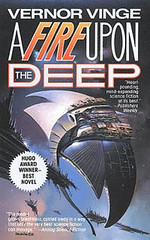
Title: A Fire Upon The Deep
Author: Vernor Vinge
Publisher: Gollancz
The human race has managed to transcend the slow zone of the universe, though it wasn’t easy, and Earth is a distant memory. The universe is filled with a wild variety of races, life forms that rise and fall – struggling forth from the slow zone through the beyond, until they transcend and become Powers or die out. A group of human’s from Sjandra Kei, a predominantly human demesne, have discovered an archive. Their hope is that this millions of year old well of information will give them a new edge. Though of course, they have to approach any archive like this cautiously, wary of unleashing a singularity. Unfortunately, the fragments of intelligence in the archive are smarter than they are, and draws them in. At the last minute they realise what they have done and try and escape with what they hope is an item that will prevent the intelligence gaining full power.
However, the power breaks free, and only one ship survives, crashing deep into the Slowness. Where only Jefri and Johanna make it through the attack by the inhabitants of the planet they land on. Tines world, inhabited by dog/rat like creatures, life forms that are only intelligent in pack formations. Two different forces get each of the children, and they each believe that they are the only survivor. A tension and potential for betrayal that is set up early in the novel, though the punch line is a long time coming.
Powers come and go. A lot of people are confident that what they are seeing from the Sjandra Kei Blight is a Type II power – one that will burn itself out in a decade or so, probably only killing a few million life forms in the process. But as time passes, the Blight starts to destroy powers, to devour galaxies, to start searching for something. So that it becomes clear, this is no ordinary power, this is something incredibly ancient, incredibly malignant. Ravna is the only human on Relay, a strategically placed station, that works between this area of space and the transcend. This makes her uniquely qualified to deal with queries from an elder power from above. A power that hacks together body parts until it has its own human – Pham. But with the destruction of Relay, and the discovery that someone survives on Tines world, Ravna and Pham have to get down there and hope that whatever was taken from the archive will stop the Blight.
Vernor Vinge takes the ideas of Singularity, of intelligence expanding exponentially and threateningly, as featured in his early novella True Names, and extends that into a Space Opera template. Despite being published in the early 1990’s, A Fire Upon The Deep feels particularly contemporary, and gives many of the recent purveyors of Space Opera a run for their money. Like True Names, Vinge adds fantasy elements, the Tine’s world is medieval, the group mind set-up having prevented the development of technology. So the novel works between castles and tribes, overwhelmed by the arrival of outsiders. Which compares to Pham’s memories, fractions of histories put in his head of mankind’s own medieval period. While he and Ravna make a mad dash, hunted by the fleet of the Blight and a genocidal force that believes that humans are responsible for everything that is going wrong.
A Fire Upon The Deep is just short of 600 pages, and at times it maybe feels a little long. Especially as the inevitable confrontations and revelations build to a point where you start to think you are going to burst if Vinge doesn’t deliver soon. But to a degree, that need for deliverance, and the lightness of Vinge’s writing keeps you turning the pages.
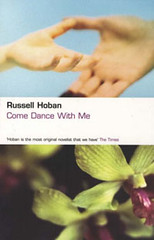
Title: Come Dance With Me
Author: Russell Hoban
Publisher: Bloomsbury
Christabel Alderton and Elias Newman meet at an exhibition of symbolist paintings. Christabel is sucked into a painting by Odilon Redon, that of The Cyclops – sucked in and overwhelmed. Elias is intrigued by her reaction to the painting, and when he approaches her she invites him to come dance with her – specifically quoting in German from a ballad about the Erlking’s daughter. Thus Hoban’s latest weirdoes and potential lovers meet.
Christabel Alderton is in her 50’s, the lead singer of a moderately successful Goth Rock band called Mobile Mortuary. Elias Newman is a failed poet who has instead relied on his career as a diabetologist. From the start there are numerous coincidences, little things that suggest that it was inevitable that they would meet. However, since the age of 13 people around Christabel have died, and in the last 40 years she has left a trail of dead lovers and would be lovers. Fearful that Elias will be the latest she is reluctant to get involved, seduced by her mystery he is convinced that what ever is going on he is the man to sort it.
Come Dance With Me was published in hardback at the start of last year, so it pre-dates Linger Awhile which went straight to over-sized paperback at the start of the year. This paperback edition of Come Dance With Me has just been published in the last few months, and continues the stream of novels that Hoban has written in recent years. Connecting into the Angelica’s Grotto, Bat Tattoo and Amaryllis Night And Day sequence – with Elias being a friend of Peter Diggs, meeting him and Amaryllis shortly after his first encounter with Christabel.
Like much of Hoban’s work Come Dance With Me is at least primarily set in London, revolves around the central couple, and juggles melancholic wit with quirky weirdoes and a certain mystery. The world of a rock musician is a slight departure from the artists and writers who usually crop up, desperate for inspiration – but to a degree Elias fulfils that role, with Christabel being the alluring dark lady, the back stage, the concert hall and the rehearsal room just being a change of scenery.
To a degree Come Dance With Me is a subdued novel, filled with remembered death, more so than the great hopping thing that dwells within Linger Awhile – Come Dance With Me fitting well with those recent novels, while Linger Awhile goes back to an earlier style.

Title: Vibrator
Author: Mari Akasaka
Publisher: Faber and Faber
Rei Hayakawa has voices in her head. The voices keep her awake at night. But it’s ok. She has discovered that if she drinks heavily the voices go quiet. Problem is the drink was making her fat. But it was about that time she learned about self-induced vomiting. So between the alcoholism and the bulimia she feels wonderful. Kind of.
One night Rei is zoning out in a supermarket. She made the mistake of digesting her dinner, so she won’t be able to vomit it back up. So she is contemplating heavy drinking and the crap that you get in women’s magazines that dictate how women should feel and think. When she clamps eyes on a handsome stranger. The voices in her head go off like a siren. She must have this man. Dropping the bottles to the floor, she follows him out into the snowy streets of Tokyo, where he is waiting in the cab of his truck. Thus starts their journey together.
Vibrator is a novella about one woman’s mania. An intense little book, that at times feels mad and random as we follow the waves of Rei’s thoughts. There are sexually charged moments as she and the truck driver explore each other. But the journey becomes more about self-discovery – the cab of the truck gives her a unique view over the world, it feels warm, comfortable and safe, and there is something about the vibrations.
To a degree Vibrator reminds of Tama Janowitz’s Peyton Amberg. Or at least what I expected Peyton Amberg to be having read the first chapter. The violent intensity of a woman, the crashing wreckage of life driven by raw emotions. However where Peton Amberg quickly becomes a book about a New York couples relationship, Vibrator sustains and builds the visceral sensations. The fact that it is a short book no doubt helps, allowing it to suck you in and spit you out in a stripped down and deliberate fashion.
Travel: Trip to London - Part 2
Date: 23rd-25th March 2006
Sunday. I had arranged to meet Squirmelia at 12 on Sunday, at South Kensington station. Up and about before then, I decided to head back to the area of the British Museum and try and find some of the comic/book shops I had had pointed out on Thursday night. Though by the time I got there and managed to get myself on entirely the wrong side of the museum I decided it was time to head to South Kensington.
I got there a little early, so tried to decide the best place to wait for Squirmelia. Our plan was to check out the museums, so I though there might be a particular exit – rather there is a big long corridor extending from the underground station, with exits all along it for the Natural History Museum, the Victoria & Albert and the Science Museum. So I went back to the station and hung around the exit from the platforms kind of area.
Once Squirmelia got there we decided to start with some brunch. We had a look around the outside of the station, but didn’t really see anything. So decided that we would try one of the museum café’s, the V&A was our first stop, so that is where we ate. We had a pie and veg, followed by a bit of cake and caffeine, before heading into the museum.
One of the reasons I had decided to go to the V&A was because of Russell Hoban. Most of his novels are set in London, with several having his characters visit the V&A, where they will come upon a certain object which will affect events that follow. The main two I could remember were the Chinese Bat Bowl from The Bat Tattoo and the statue of Shiva dancing from Her Name Was Lola. Squirmelia in the meantime was looking for ritualistic objects of power, to see if she could find something that could be used to bring the giant squid in the Natural History museum back to life. Which was fine with me too.
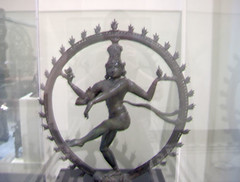
Statues of Shiva dancing, with one foot crushing the baby demon of ignorance Apasmara Purusha, which had made the lead character in Her Name Was Lola forget all about Lola, were readily found. There were a couple of versions of the station, in amongst a selection of other related gods and goddesses. However the Bat Bowl which was instrumental in the meeting between Sarah and Roswell in The Bat Tattoo proved to be more elusive. I searched through the Chinese collection and didn’t come across it, then we wandered through the Japanese and Korean collection while we were there.
From the Japanese collection:
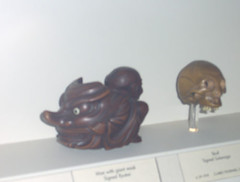
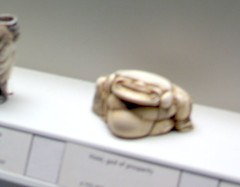
Between the Indian and Asian galleries we came across a new exhibit, a colourful collection of fashion items – the more out there and over the top pieces that you get, like a fur coat, made from black teddy bears stitched together. Or a sofa, made from various teddy bears, unfortunately not shown in the image – the dummy had a foot on a black leather bear, which recalls Shiva and the Apasmara Purusha. A Hello Kitty headed model and cartoon character dresses
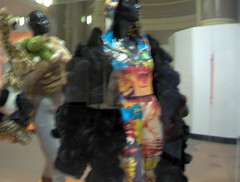
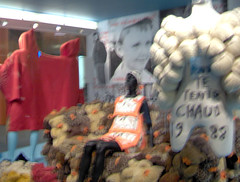
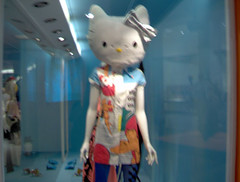
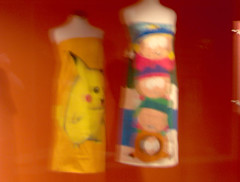
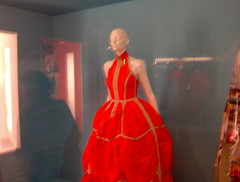
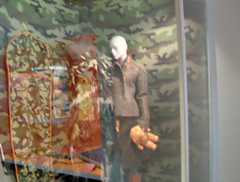
Squirmelia and I took a load of photos of the interesting stuff, while pretty much ignoring the permanent exhibit of mundane stuff.
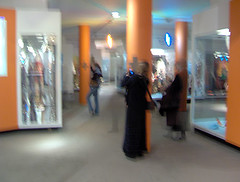
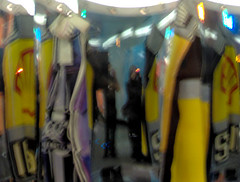
Though it was while we were going round this section, I realised that I had picked up a stalker. This girl had been in the Tate the day before prior to the talk by Alan Moore, and here she was again.

Unfortunately after that we managed to lose her. Oh well. Maybe next time?
Having come in from the train station, we had come in the back entrance to the V&A, which means that we hadn’t seen the sculpture by Dave Chihuly. A huge hanging chandelier hydra like object, all tentacles and tumescent growths, that seemed to writhe and slither.
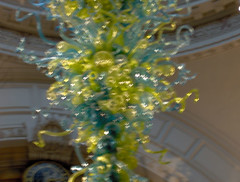
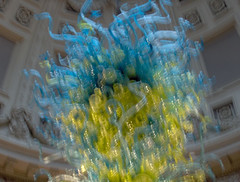
By this time we had been in the V&A for some hours, so decided we would move on to the Science Museum. So it was back out the tunnel and along to the next exit. Again we started our visit by a stop in the café, where we had a drink surrounded by bright colours and loads of families. Though that didn’t stop us making our first stop within the museum the interactive kid’s section. Though we kind of wandered around aimlessly, as it was kind of difficult to actually get hands on the hands on stuff for all the kids. Though we managed to shake hands with herself, and thanks to the horror’s of science, Squirmelia had her shadow stripped from her!
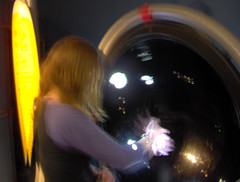

From the hands on section, we went looking for further Russell Hoban references, this time in the Math department – Klein Bottles – the spiralling interwoven glass structures that featured in Amaryllis Night and Day. These objects were thought to be impossible, while they could be described by mathematics, it wasn’t until Alan Bennett was able to construct them from glass that they became actual objects.
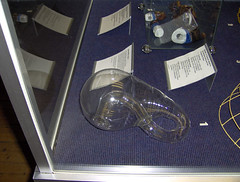
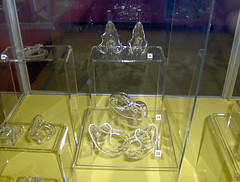
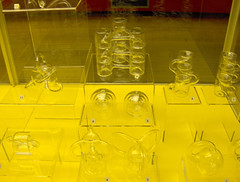
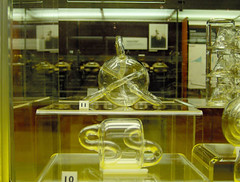
While there I came across another literary reference. The Difference Engine. Babbages early steps towards the computer, calculating machines using gears and the like. Which was the name of William Gibson and Bruce Sterling’s collaborative Steam Punk novel.




From the Math Department we wandered into the Energy Department. Where there were a series of interactive little items about energy – its generation, use and conservation. Including games where you stamp on floor buttons to affect what happens on a screen, a pole that gives electric shocks, a city model, and the idea of bodily wastes being a valuable resource.


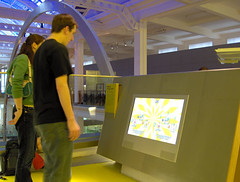

By this time it was getting close to closing time. So we decided to pop into the shop, see if they had anything cool. That was clearly a big mistake, as every child in the entire building had converged there. It was like a feeding frenzy, all these tiny hands clawing up plastic dinosaurs, key rings, pens and the usual souvenir tat. Regardless, we were still the second last people to get our coats and bags from the cloakroom, much to the annoyance of the put upon staff.
Fighting our way past the cannibalistic child frenzy, we made it outside, and ducked back into the long museum corridor to get a train back to the centre. Where we went for pizza, passing the Odeon in Leicester Square, where the paraphernalia of the V For Vendetta premier were still on display.

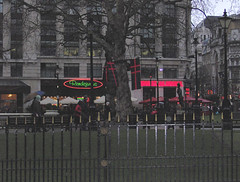
After dinner, Squirmelia headed for a train home, her weekend over, back to work the next day. I still had another day to go, so I took my time, wandered up Tottenham Court Road, where half the second hand bookshops were still open. I didn’t find anything that I was after, so I just headed back to the hotel. Taking my position in the computer room, waiting for Spanish kids to get off the computers, drinking the even more dwindling caffeine options from the dispenser and reading.
Monday. My last day in London. Having already experienced wandering around on the Thursday with my extra baggage, I had no intention of repeating that. So my first trip of the day was to King’s Cross, where I found a left luggage and left my bags. Of course these kind of places have changed in recent times, the left luggage including the full airport style luggage scanning x-ray machine. I grabbed a chicken and vegetable Cornish pasty in Kings Cross station for breakfast – the kind I always have when I get one from the franchise stall in Glasgow Central.
My next stop I thought would be Forbidden Planet, then the other book and comic shops in the area. But as I headed into the underground I changed my mind. Back to Camden! For a number of reasons, Kradlum had confirmed which street the Camden comic shop I could remember was in, I had seen a couple of paintings I had liked while there on the Friday, and Crash had posted online to suggest that we should have taken more pictures when we had been there. Unfortunately, I found the comic shop too late, the comics I was looking for had just sold out half an hour ago – comics that would have been there on Friday as I walked past and said to Crash, "There is a comic shop down one of these streets". Regardless, I went up, bought the paintings I wanted, then took a load of photos of the Camden markets. Unfortunately, when we had been there on Friday it had been quite clear, and there had been a good buzz. Returning on a Monday morning, a grey drizzly Monday morning, didn’t really give the same atmosphere.
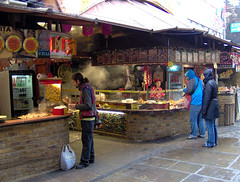

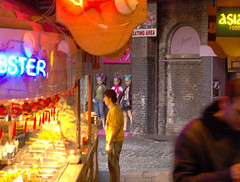
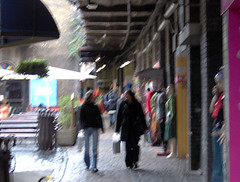
From Camden, I went back to my previous plan, into Forbidden Planet and whatever other book and comic shops I could find. Managed to find one comic shop that had one of the three comics I was looking for, then Gosh comics which I had failed to find the day before, where I bought a pile of reduced graphic novels. Then to Forbidden Planet where I bought a couple of books. After that I went for a cup of tea and read for bit. Before heading back to the British museum for another look around there.
On Thursday night we had looked through the doors into the library as it was closed at that time of night, this time I went in and took a couple of pictures. Before heading up to the oriental exhibits, where they advised you not to drop to the floor below!



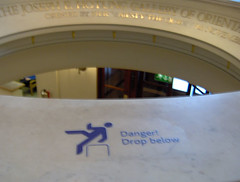
In the Thai section I found another statue of Shiva dancing, this one a winged version. I also decided to actually focus on Apasmara Purusha this time.
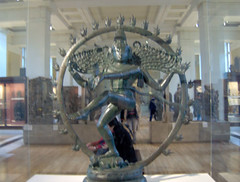
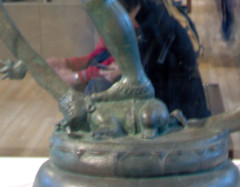
From the Thai and Chinese exhibits, I wandered up more stairs to the Korean exhibit.
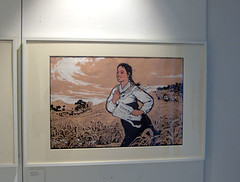



Back on the ground floor there was an African exhibit:


After the British museum I went for a sandwich, killing time before I headed out to the airport. I was trying to time it that I got to the airport on time, without having too much time to kill. But of course, London is a city that will devour you if you let it. So when I decided that it was time to head back to Kings Cross I found myself stymied at every turn. As I went back and forth between stations, trying to find a line that was still running to Kings Cross the words pieced together, a personal action, became someone on the tracks. Finally I found on my fourth attempt a line that ran on different tracks that still went to Kings Cross. Where I was able to reclaim my bags, and switch to the Kings Cross Thames Link to Luton Airport. There I made the mistake of getting on the Luton train, the train that at peak times like this is absolutely and ludicrously filled with people and stops at every stop before Luton.
Once I got to the nearest station, getting to the airport and checking in was no problem. I decided that maybe I would have some dinner. Offered chicken pie and mash I decided to go for that, however there was no pie – so instead I was offered boiled rice and gravy. The pie was also chicken with stuffing, which was just odd. Overall a meal I can very much recommend you avoid! Despite my best attempts, I ended up buying fries from Burger King, since the pie and rice had been so disappointing, and the guy at the next table was eating from Burger King. The rest of the evening was spent reading, flying, reading, getting home. And back to work the next day.
 this is the voice of re:mote induction.
this is the voice of re:mote induction.